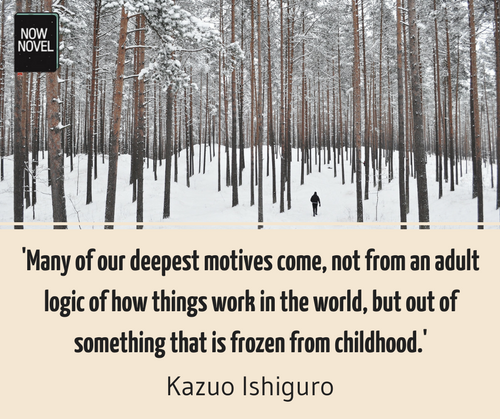Believable character motivations drive all of literature’s most famous characters. Characters, like real people, have desires, wants and needs. They have motivations they’re aware of and ones they aren’t. These all impact the choices they make. Here are 7 tips for creating character motivation:
1: Give each character their own credible motivation
2: Give characters conscious and unconscious motivations
3: Show how motives stem from rational and irrational beliefs
4: Develop characters’ motivations with new plot events
5: Don’t give characters what they want too easily
6: Allow subtlety when revealing what drives your characters
7. Make motivations complex to increase suspense
Let’s expand each of these suggestions further:
1: Give each character their own credible motivation
People have differing formative experiences, different upbringings and personalities. All these different factors affect their values and motivations.
For example, in a fantasy novel where characters go on a dangerous quest, one might be a money-hungry assassin who is in it for the pay. Idealism and nobility simply aren’t values they hold. They’re practical and calculating, unfeeling.
Another in the party, meanwhile, has a restless spirit. They’re just tagging along for the adventure and can’t bear to be in one place too long.
What makes a character’s motivation credible/believable?
- It’s makes sense if we hear the character’s backstory: Perhaps the assassin lived on the streets and had to learn to fend for themselves and this hardened them. Perhaps the adventurer grew up in a small town but always had an inquisitive mind and yearned to see what lay beyond the next horizon
- It’s grounded in cause and effect: People don’t all respond the same to similar situations. Yet there are certain similarities. A lover jilted at the altar, for example, would likely find it difficult to trust a new romantic partner. Motivations are believable when we understand why people seek the paths they do
Character motivations don’t necessarily need to be made explicit. In many horror novels, part of the mystery and thrill is not knowing exactly why a malevolent entity terrorizes its victims. Yet there are always at least some characters who show psychological cause and effect in their behaviour.
Establishing what drives your characters helps readers to understand why your story pans out the way it does. It lends cohesion – the story just makes inherent sense.
Besides characters’ motives making sense, they should be interesting. One way to keep motivations interesting is to vary how aware characters are of their own motivations:
2: Give characters conscious and unconscious motivations
Just like you or me, characters might not always fully understand their own behaviour. Conscious motivations are the factors driving us we’re aware of. For example, in Orwell’s famous sattire Animal Farm (1945), Old Boar summons the animals together to urge them to revolt. He does this because he’s conscious of the power difference between humans and animals on the farm.
Conscious motivations are important because as readers we enjoy characters who are active, who take charge of their fates and act. Yet unconscious motivations are powerful for deeper characterization. They reveal character psychology.
Unconscious motivations are the drives and impulses characters don’t always understand. A character might, for example, self-sabotage out of low self-esteem. This behaviour pattern could stem from abuse earlier in life, such as being bullied badly in school.
You could show readers separate situations (the character’s struggles later in life and the trauma factor of having been bullied) without drawing this link explicitly. This is where fiction can be powerful, as your reader can have a broader view and understanding of your character’s motives and patterns (and more empathy for them) than the character has.

3: Show how motives stem from rational and irrational minds
The sociologist Max Weber gives this definition of the difference between rational and irrational motivation:
‘[I]f we know that someone is cutting wood for a living or to provide for his own needs or as a form of recreation, these would be examples of rational motivation; on the other hand, if he is simply working off a state of emotional agitation, then this would be an example of irrational motivation.’
The truth is that most people follow a mix of rational and irrational motivations. Sometimes you might chop wood because you want to light a fire or have a barbecue. Sometimes you might chop wood to keep busy and ease agitation. The underlying cause might not match the action taken quite so clearly.
For true variety in your cast of characters, individuals’ motivations should lie on a scale of rationality/irrationality.
Some characters might be primarily irrational in why they do things. They might be all impulsive, unconscious drives.
Others can be hyper-rational, never taking any action unless the immediate, practical benefits are clear to them. The latter type is typical of the detective figure in crime and mystery novels (for example, Agatha Christie’s punctual Belgian detective, Hercule Poirot).
4: Develop characters’ motivations with new plot events
To keep your characters interesting, let their motivations develop as your story unfolds. For example, in Paula Hawkins’ smash hit thriller The Girl on the Train (2015), the protagonist Rachel initially stalks her ex and his new flame out of hurt and poor boundaries due to developing alcoholism. Yet once she notices dangerous entanglement between them and another couple living nearby, her motivation shifts to wanting to uncover the truth about her ex-husband.
When major plot events occur, think about how they might change your character. In Hawkins’ novel, Rachel manages to quit drinking periodically after discovering unsettling facts, motivated by her focus in solving the mystery she discovers. This motivation shift keeps Rachel interesting.
Major developments that can spark new character motives include:
- New relationships with other characters
- A sudden loss or gain
- A change in career path
- Mysterious discoveries
Changing characters’ drives and desires over time creates a sense of development that makes characters feel real and engaged with their world and their circumstances.

5: Don’t give characters what they want too easily
Make sure that your characters’ actions don’t lead in a straight line to getting what they want, even if their motivations are clear. Because this will likely make the character arc feel predictable.
Obstacles and complications intrigue us because we become invested in knowing the answer to a burning question (for example, ‘Will the protagonist and her love interest unite despite their meddling families [the obstacle]?’)
Victories and achievements are often hard-won. Making the paths to your characters’ goals strewn with setbacks creates dramatic interest as well as a heightened sense of realism.
6: Allow subtlety when revealing what drives your characters
It feels stagy when characters announce their motivations explicitly. Although this device has been used effectively (from Shakespeare to the scheming central character in Netflix’s House of Cards), it could feel stagey, like a great big slab of telling.
Instead, show the origins of your characters’ desires and behaviours through scenes.
Sometimes you may need to have your character state motivations out loud, but showing what drives them as a building arrangement of memories, fears, beliefs and ongoing experiences will make it easier for readers to draw their own conclusions about characters’ behaviour and why it is significant.
7. Make motivations complex to increase suspense
A simple, single motivation creates potential for many interesting scenes and plot developments.
Yet a more complex motivation can create heightened tension and uncertainty.
For example, in a historical or fantasy novel, a military adviser to the king could have a simple motivation of loyalty due to familiarity and mutual reliance. This is a simple motivation. Yet what if there are additional circumstances complicating his position?
For example, what if they are planning to lay siege to a city where he (unknown to the king) the adviser has a lover he wants to keep safe? An outbreak of war between the two kingdoms could create a conflict of interests where there is tension between two simultaneous held wants and desires.
Give characters multiple motivations as you plan your plot, since people tend to juggle multiple desires that push and pull them along different courses of action. Characters, like ourselves, sometimes have to make tough decisions that take the story in new, suspenseful directions.
Develop character profiles and build complex, detailed believable characters on Now Novel.
Cover source image by Mag Pole


9 replies on “Character motivation examples: 7 tips for clear motives”
Great post! I’m especially fond of the part about irrational motivations; I’m a marketing student as well as a writer and I’ve noticed the shift in perspective toward viewing consumers as irrational, something writers have understood for a long time. Thank you for laying it out the way that you did!
Hi Evelynn, thanks for the kind feedback! Interesting that idea of using psychological insights from marketing in how you create characters. Thanks for sharing your thoughts.
Thanks for this post. indeed, humans are complex creatures. Hardly do we all have only rational motivations without one or two irrational ones in the mix. How true that Literature is life itself.
Thanks for dropping in, Ohita. Very true. I think we like to think we’re more rational than we are, maybe. The best literature does often capture and reveal something true about life.
Very helpful as I am at the stage where I need to develop characters to really put body into my stories. No doubt about human complexity. Feels as if we need to be aware of the psychology of each character we create.
Hi Glenys, glad to hear this helped! It’s true that it really does help to know who your characters are inside out. It makes it easier to imagine how they’d react in a given situation. Have you tried the ‘character interview’ approach, asking questions of your characters as though they were living people and writing down how you imagine they’d respond? Thanks for reading and commenting!
Your posts are the best. They are so helpful!
Thanks so much, Eryka. Glad you’re finding them helpful.
Good content shared. Very helpful and reliable. Thanks for sharing this. Really appreciate it and keep up the good work.